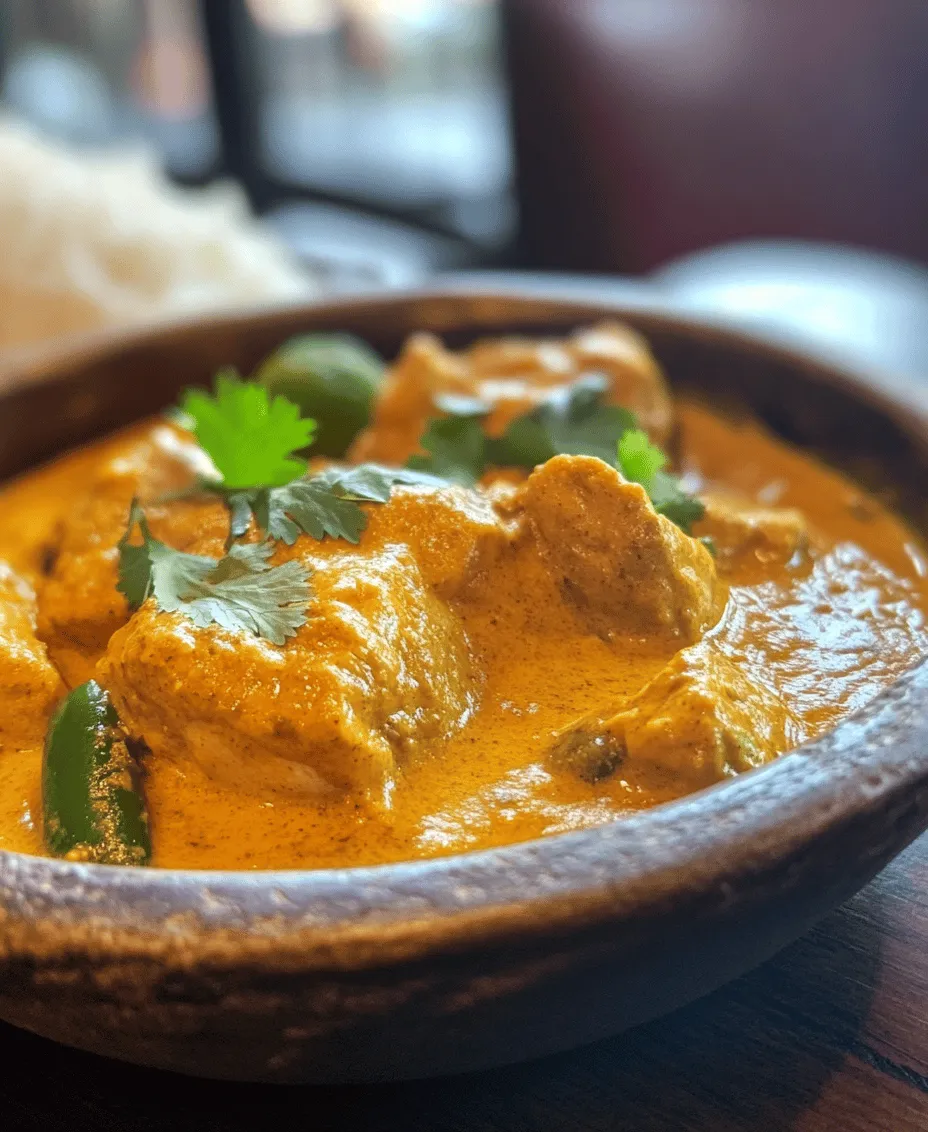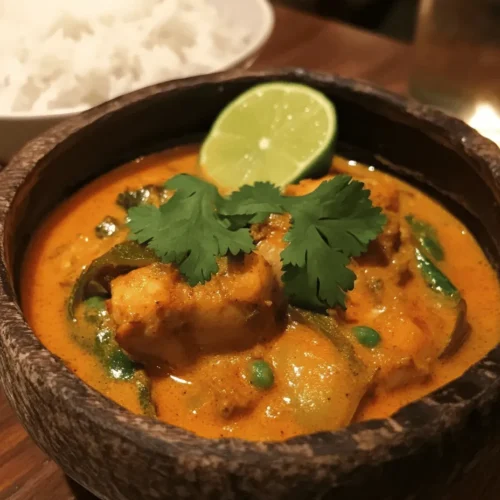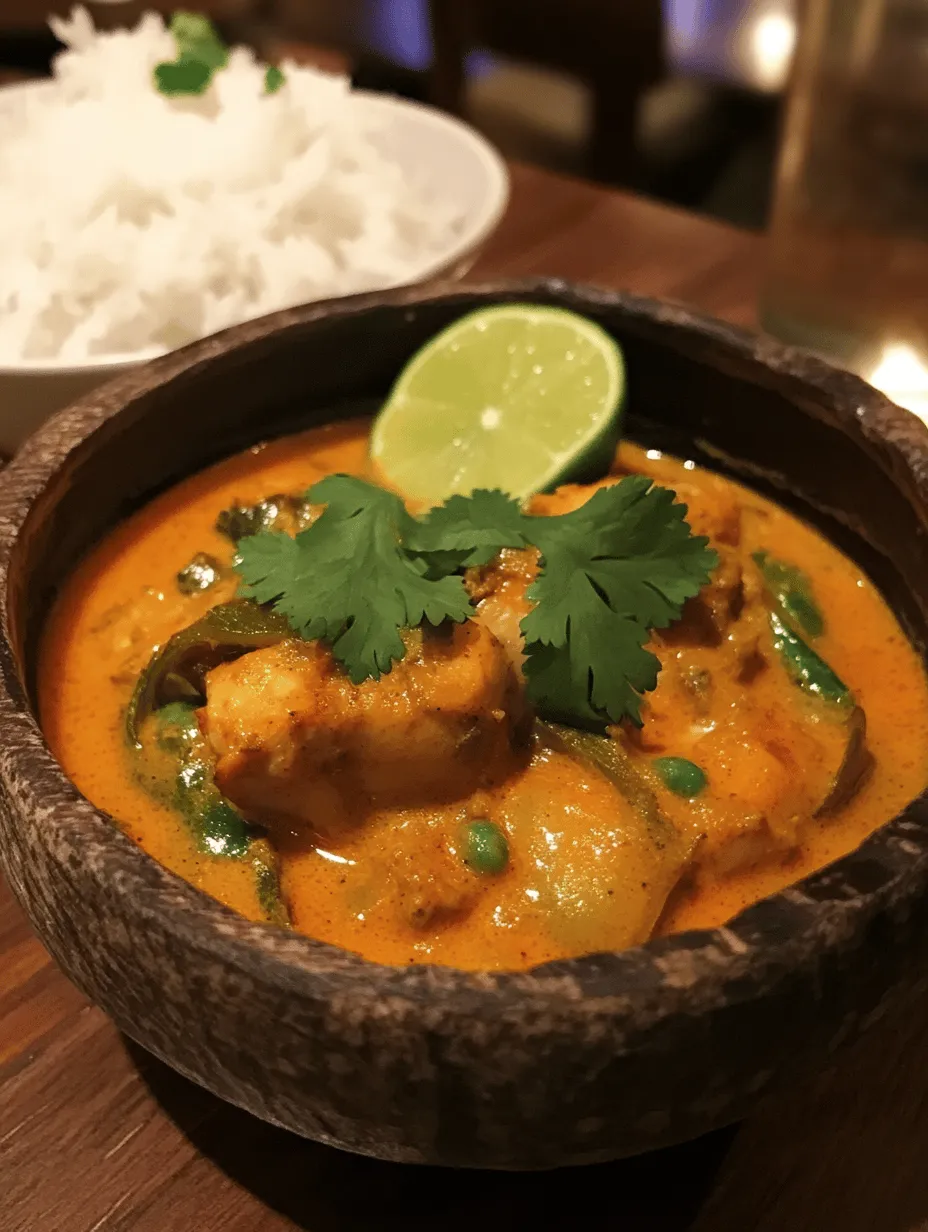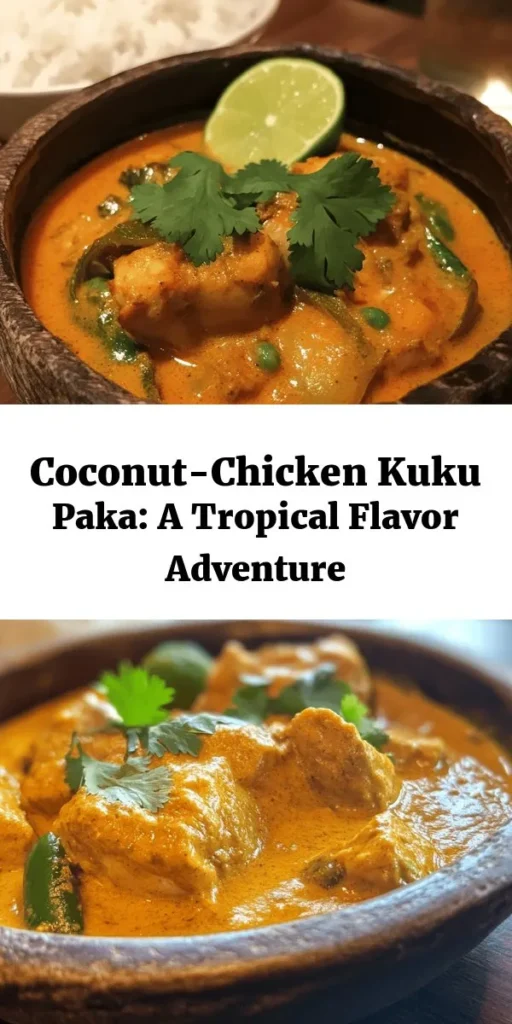Introduction
Kuku Paka, a cherished dish in East African cuisine, encapsulates the essence of flavorful cooking—bringing together the richness of coconut, the warmth of spices, and the succulence of chicken. This delightful recipe hails primarily from coastal regions like Kenya and Tanzania, where it has become a staple in both homes and restaurants alike. The dish is not just a meal; it represents a blend of cultures and traditions that reflect the diverse culinary influences found in East Africa.
At its core, Kuku Paka is a perfect illustration of how simple ingredients can be transformed into a culinary masterpiece. The combination of coconut milk and spices creates a creamy, aromatic sauce that envelops tender pieces of chicken, making every bite an explosion of flavor. This dish is not only comforting but also showcases the art of balancing flavors—a hallmark of East African cooking.
The cultural significance of Kuku Paka extends beyond just being a favorite dish. It is often prepared for special occasions, family gatherings, and celebrations, embodying the spirit of community and togetherness. Depending on the region, variations of Kuku Paka can be found, each with its unique twist, showcasing local ingredients and cooking techniques. In some areas, you might find it served with rice or chapati, while others might pair it with ugali or plantains, highlighting the dish’s versatility and adaptability.
Understanding Kuku Paka
Kuku Paka, translated as “chicken in coconut,” finds its roots in the Swahili culinary tradition. The dish originated along the Indian Ocean coast, where the influence of Indian spices and cooking methods merged with local ingredients, particularly coconut milk, to create a distinctive flavor profile. The use of coconut in cooking is prevalent in many coastal cuisines worldwide, but in East Africa, it has been embraced with an enthusiasm that speaks to the region’s tropical climate and agricultural practices.
In East African culinary traditions, Kuku Paka occupies a special place as a comfort food that can be enjoyed by families and guests alike. It is particularly popular during festive seasons and gatherings, where the aromatic flavors can fill the air, enticing everyone to the table. The dish has evolved over the years, with each region putting its own spin on the recipe. For example, some chefs may add additional vegetables, while others might increase the heat by incorporating more chilies. This adaptability is part of what makes Kuku Paka so beloved—its ability to cater to individual tastes while remaining true to its roots.
Ingredients Breakdown
To create a truly authentic Kuku Paka, understanding the role of each ingredient is essential. Let’s break down the key components that will bring this dish to life:
Chicken
The heart of Kuku Paka is, of course, the chicken. When selecting chicken, quality is paramount. Opt for free-range or organic chicken when possible, as it tends to have more flavor and a better texture. Preferred cuts for this dish include thighs and drumsticks, as they remain juicy and tender during cooking. However, chicken breasts can also be used for a leaner option.
Vegetable Oil
Choosing the right oil is crucial for cooking Kuku Paka. While any neutral oil can work, options like coconut oil or sunflower oil are often recommended. Coconut oil will enhance the dish’s tropical flavor, while sunflower oil provides a lighter base for frying.
Onions
Onions are a fundamental ingredient in many cuisines, and Kuku Paka is no exception. They serve as the base for flavor development, providing sweetness and depth to the dish. Yellow or white onions are typically used, but red onions can also be employed for a slightly different taste.
Garlic and Ginger
These aromatic roots are essential in Kuku Paka, contributing to its signature flavor. Fresh garlic and ginger should be minced or grated to release their oils and fragrances. Together, they create a robust backdrop for the spices and other ingredients.
Green Chilies
For those who enjoy a bit of heat, green chilies are a must. They can be adjusted according to personal preference; simply add more for a spicier dish or reduce the amount for a milder version. Slicing the chilies helps to distribute their heat throughout the dish.
Spices
The spice blend used in Kuku Paka is critical for achieving its distinctive flavor. Cumin, coriander, turmeric, and paprika are common staples. Cumin adds an earthy and warm note, while coriander brings a citrusy brightness. Turmeric not only lends a beautiful golden color but also a subtle bitterness, and paprika provides a sweet smokiness that rounds out the spice profile.
Coconut Milk
Coconut milk is the star of Kuku Paka, giving the dish its creamy texture and rich flavor. When choosing coconut milk, look for a high-quality brand that is free from additives and preservatives. Full-fat coconut milk will yield the richest results, but light coconut milk can be used for a healthier alternative.
Chicken Broth vs. Water
When preparing Kuku Paka, the choice between chicken broth and water can significantly impact the dish’s flavor depth. Using chicken broth adds a layer of umami and richness, elevating the overall taste. However, if broth is unavailable, water can be used, although the flavor will not be as robust.
Fresh Cilantro and Lime
To finish off the dish, a sprinkle of fresh cilantro and a squeeze of lime juice are essential. Cilantro adds a fresh, herbaceous note that brightens the dish, while lime juice provides acidity to balance the richness of the coconut milk.
Marinating the Chicken
One of the key steps in preparing Kuku Paka is marinating the chicken. This process is vital for infusing the meat with flavor and ensuring it remains tender throughout cooking. The marinade typically consists of a blend of spices, garlic, ginger, and a touch of salt, allowing the chicken to absorb the aromatic flavors.
The recommended marination time is at least 30 minutes, but for the best results, consider marinating the chicken for several hours or even overnight. This extended time allows the spices to penetrate deeper into the meat. For those with dietary preferences or restrictions, adjustments can be made to the marinade—such as reducing the amount of salt or opting for low-sodium options—without sacrificing flavor.
When marinating, ensure that the chicken is coated evenly and stored in a covered container in the refrigerator. If you are short on time, even a quick 15-minute marination can enhance the flavor, although longer is always better.
Cooking Techniques
Cooking Kuku Paka involves a few simple techniques that help to build layers of flavor. The dish can be prepared using traditional stovetop methods, which allows for precise control over cooking times and temperatures. Common methods used include sautéing, simmering, and reducing, all of which contribute to the development of the dish’s rich sauce.
Begin by sautéing the onions in your chosen oil, allowing them to become translucent and fragrant. Next, add the minced garlic and ginger, stirring until aromatic. Incorporate the marinated chicken and cook until browned, sealing in the juices. Once the chicken is partially cooked, add the spices and green chilies to the pan, stirring to coat the chicken evenly.
Afterward, pour in the coconut milk and chicken broth, allowing the mixture to come to a gentle simmer. This slow cooking process enables the flavors to meld together, resulting in a harmonious dish that is both comforting and satisfying.
As the Kuku Paka simmers, it’s important to monitor the heat to avoid boiling, which can cause the coconut milk to separate. Instead, aim for a low simmer, allowing the chicken to cook through while the sauce thickens.
This initial part of the recipe sets the stage for an unforgettable culinary experience as we dive deeper into the preparations and serving suggestions for Kuku Paka. Stay tuned for the next part, where we will explore additional cooking techniques and tips to perfect this delectable dish.

The Steps to Perfect Kuku Paka
Creating the perfect Kuku Paka requires attention to detail and an understanding of how each step contributes to the overall flavor and texture of the dish. Here’s a detailed walkthrough of each cooking step:
Marination Process and Timing
Begin by marinating the chicken. This step is crucial for infusing the meat with flavor. Use a combination of yogurt, lemon juice, garlic, ginger, and a pinch of salt. Aim to marinate the chicken for at least 1 hour, but for best results, let it sit overnight in the refrigerator. This allows the flavors to penetrate deeply, yielding tender and juicy chicken.
Sautéing and the Importance of Timing for Aromatics
Once marinated, it’s time to sauté the aromatics. Heat a generous amount of oil in a large pan over medium heat. Add finely chopped onions, stirring frequently. The goal here is to achieve a golden brown color; this process will take about 10-15 minutes. Sautéing onions not only enhances their sweetness but also adds depth to the overall flavor profile of Kuku Paka.
Once the onions are caramelized, add minced garlic and grated ginger. Timing is critical; these should be added after the onions have browned to prevent them from burning. Sauté for another 2-3 minutes until fragrant, ensuring they don’t scorch.
Layering Spices: Techniques for Toasting Spices for Enhanced Flavor
Next, it’s time to layer in the spices. Common spices for Kuku Paka include cumin, coriander, turmeric, and garam masala. Toast these spices in the pan for about 1-2 minutes, stirring continuously. Toasting spices releases their essential oils and enhances their flavor, giving your dish a warm and aromatic profile. The kitchen should be filled with an enticing aroma at this point.
The Critical Moment of Adding Coconut Milk and Broth
Once your spices are toasted, it’s time to introduce the chicken. Add the marinated chicken pieces to the pan, ensuring they are well-coated with the spice mixture. Sear the chicken for about 5-7 minutes on each side until nicely browned. This step is essential for developing a rich flavor and creating a beautiful texture.
After searing the chicken, pour in the coconut milk and chicken broth. The combination of these two liquids creates a creamy sauce that is essential to Kuku Paka. Stir well to combine, ensuring that all the spices and chicken are incorporated. Bring the mixture to a simmer.
Tips for Achieving the Perfect Simmer
Simmering is the key to tenderizing chicken and developing the sauce’s flavors. Reduce the heat to low and cover the pan. Let it simmer gently for about 25-30 minutes. Avoid boiling, as this can make the chicken tough. Stir occasionally and check to ensure the sauce doesn’t stick to the bottom of the pan. You want the chicken to absorb all the delicious flavors while remaining juicy and tender.
Serving Suggestions
Kuku Paka is a versatile dish that pairs wonderfully with various sides. Here are some traditional accompaniments and presentation ideas:
Traditional Accompaniments: Ideal Pairings with Kuku Paka
– Steamed Rice: Basmati rice is a classic choice, complementing the creamy sauce and allowing the flavors to shine. The lightness of the rice balances the richness of the coconut milk.
– Chapati: This flatbread is perfect for scooping up the chicken and sauce. Its slightly chewy texture and ability to absorb flavors make it an excellent accompaniment.
Presentation Ideas for a Beautiful Serving Platter
For an appealing presentation, serve Kuku Paka in a large, shallow bowl, garnished with fresh cilantro and lime wedges. This not only adds a pop of color but also invites guests to squeeze fresh lime juice over their servings, enhancing the dish’s flavor.
Nutritional Information
Kuku Paka is not only delicious but also packed with nutritional benefits:
Overview of the Health Benefits of Kuku Paka
– Chicken: A great source of lean protein, essential for muscle development and overall health.
– Coconut Milk: Contains medium-chain triglycerides (MCTs) that can provide energy and support weight loss.
– Spices: Ingredients like turmeric and ginger have anti-inflammatory properties and contribute to overall health.
Nutritional Breakdown of Main Ingredients
While specific nutritional values can vary, a typical serving of Kuku Paka (with chicken, coconut milk, and spices) contains approximately:
– Calories: 350-400
– Protein: 25-30 grams
– Carbohydrates: 10-15 grams
– Fats: 25-30 grams (mostly healthy fats from coconut milk)
Suggestions for Balancing the Meal with Vegetables
To create a balanced meal, consider serving Kuku Paka with a side of steamed vegetables like broccoli or carrots. This not only adds color but also increases the fiber content of your meal, making it more nutritious.
Cultural Context and Variations
Kuku Paka is not just a dish; it represents a rich cultural heritage that spans across East Africa, especially within Kenyan and Tanzanian cuisines.
Exploring How Kuku Paka Is Enjoyed in Different Cultures
In coastal regions, Kuku Paka might be served with a side of fried plantains or a fresh salad, showcasing the local produce. Variations in preparation methods can be seen, with some opting for grilled chicken while others may prefer a more stew-like consistency.
Regional Variations and Their Unique Twists on the Recipe
Some recipes include additional ingredients such as tomatoes or spinach, which provide extra flavor and nutrition. Others may incorporate local spices specific to their regions, reflecting the diverse culinary influences in East Africa.
How This Dish Reflects the History and Migration Patterns in East Africa
Kuku Paka’s origins can be traced back to the migration of people from the Indian subcontinent to East Africa, bringing with them culinary traditions that blended with local ingredients and flavors. This dish exemplifies how food can transcend borders, creating a shared cultural experience.
Conclusion
Kuku Paka is a delightful dish that encapsulates rich flavors and cultural significance. Its unique combination of coconut milk, spices, and tender chicken creates a culinary experience that is both comforting and exotic. Whether enjoyed at a family gathering or a festive celebration, Kuku Paka stands as a testament to the diverse culinary heritage of East Africa.
As you explore this dish, embrace the opportunity to enjoy its rich flavors and the story it tells. Kuku Paka is more than just a meal; it’s a celebration of heritage and the joy of sharing food with loved ones. Try your hand at this recipe and enjoy the delightful experience it offers, making it a staple in your culinary repertoire.



